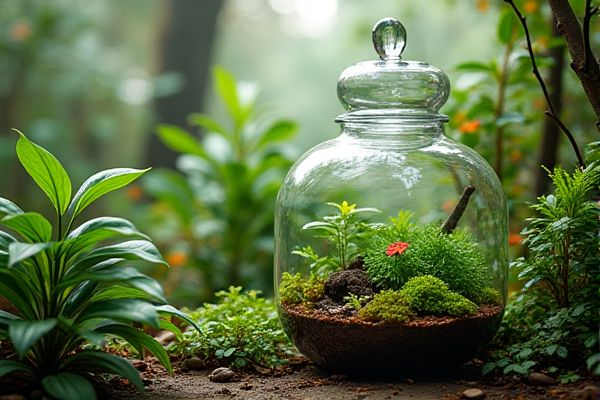
A terrarium is a sealed or open container designed to house plants and small land animals, creating a controlled environment that mimics natural habitats, focusing primarily on plant growth and humidity levels. Exploring the differences between a terrarium and a vivarium will help you choose the ideal setup for your interests and needs--continue reading to discover which environment suits your collection best.
Table of Comparison
| Feature | Terrarium | Vivarium |
|---|---|---|
| Definition | Enclosed glass container for growing plants or housing reptiles/amphibians | Enclosed ecosystem designed for keeping animals and plants in a controlled environment |
| Primary Use | Plant cultivation, reptiles, amphibians | Animal habitats with integrated plant life |
| Typical Inhabitants | Succulents, ferns, geckos, snakes | Frogs, newts, small reptiles, insects, plants |
| Environment Control | Humidity and temperature control mainly for plants | Advanced humidity, temperature, and lighting for both animals and plants |
| Complexity | Simple to moderate setup | More complex, simulates natural habitats |
| Purpose | Decorative or hobby plant and pet keeping | Research, education, and naturalistic pet environments |
Introduction: Understanding Terrariums and Vivariums
Terrariums and vivariums both serve as controlled environments for housing plants and animals, with terrariums primarily designed for plant cultivation and vivariums tailored to accommodate living creatures such as reptiles, amphibians, or small mammals. Terrariums typically feature sealed or semi-sealed glass containers to maintain humidity and airflow optimal for plant growth, while vivariums include elements like heating, lighting, and substrate to mimic natural habitats for animal welfare. Understanding the distinctions in purpose, design, and function is crucial for selecting the appropriate environment for specific horticultural or zoological needs.
Definition: What is a Terrarium?
A terrarium is a sealed or open glass container designed to house terrestrial plants and sometimes small land animals, creating a miniature, self-sustaining ecosystem. This environment mimics natural conditions by controlling humidity, light, and temperature to support plant growth. Your choice of a terrarium depends on the need for a low-maintenance, decorative habitat perfect for showcasing foliage like ferns, moss, and succulents.
Definition: What is a Vivarium?
A vivarium is a specially designed enclosure that replicates natural habitats to nurture plants, animals, or both, providing controlled environmental conditions such as temperature, humidity, and lighting. Unlike a terrarium, which typically houses only plants or small terrestrial animals, a vivarium supports a wider variety of living organisms, including amphibians, reptiles, and insects. Your choice between a terrarium and a vivarium depends on the specific requirements of the species you want to keep and the complexity of the ecosystem you wish to create.
Key Differences Between Terrariums and Vivariums
Terrariums primarily house plants or small land animals in a controlled, enclosed environment designed to replicate natural terrestrial habitats, emphasizing humidity and soil conditions. Vivariums encompass a broader range of enclosures, including aquariums and paludariums, supporting terrestrial, aquatic, or semi-aquatic species with complex ecosystems featuring diverse flora and fauna. Key differences lie in their intended inhabitants, environmental complexity, and habitat simulation, with terrariums focusing on simpler, mostly dry settings and vivariums on versatile, multi-habitat conditions.
Purpose and Function: Terrariums vs Vivariums
Terrariums are primarily designed to create a controlled environment for growing plants, often featuring soil, moisture, and appropriate light to support terrestrial plant life. Vivariums serve a broader purpose, accommodating both plants and animals, providing a habitat that caters to the biological and ecological needs of living creatures such as reptiles, amphibians, or insects. The key distinction lies in terrariums focusing on botanical growth, while vivariums aim to replicate natural ecosystems for fauna and flora interaction.
Ideal Inhabitants for Terrariums
Terrariums are ideal for small terrestrial animals such as reptiles, amphibians, and invertebrates that require controlled humidity and temperature levels. Popular inhabitants include dart frogs, geckos, and small snake species, as well as various types of tropical plants that thrive in enclosed environments. These ecosystems provide a stable microclimate essential for species that depend on high humidity and moderate airflow.
Ideal Inhabitants for Vivariums
Vivarium environments are ideal for amphibians, reptiles, and small mammals that require both terrestrial and aquatic habitats, such as frogs, newts, and turtles. These enclosures provide a controlled ecosystem with live plants, water features, and humidity levels tailored to species-specific needs. Your choice of inhabitants should consider their natural behaviors and environmental requirements to ensure a thriving vivarium setup.
Design and Setup Considerations
Terrariums require a design that emphasizes humidity control and substrate selection suitable for plant growth or small reptiles, often incorporating sealed or semi-sealed glass containers to maintain moisture. Vivariums demand a more complex setup with tailored temperature gradients, ventilation systems, and habitat-specific elements to support diverse animal species, such as amphibians or reptiles, ensuring proper air circulation and environmental enrichment. Both setups necessitate careful planning of lighting, heating, and moisture levels to replicate natural habitats effectively.
Maintenance and Care Requirements
Terrariums require consistent humidity control and regular watering to maintain plant health, making low-maintenance setups ideal for beginners. Vivariums demand more intricate care, including temperature regulation, substrate management, and habitat enrichment for animals, aligning with the needs of reptiles, amphibians, or small mammals. Your choice impacts daily upkeep, with terrariums offering simpler maintenance and vivariums requiring dedicated attention to ensure a balanced, thriving environment.
Choosing the Right Enclosure for Your Needs
Terrariums are ideal for housing terrestrial plants and animals that require a controlled, humid environment, while vivariums accommodate a wider range of ecosystems, including both aquatic and terrestrial habitats. When choosing the right enclosure, consider the specific needs of your species, such as humidity levels, temperature, and space for natural behaviors. Your decision should prioritize the habitat requirements to ensure optimal health and longevity of the inhabitants.
 homyna.com
homyna.com